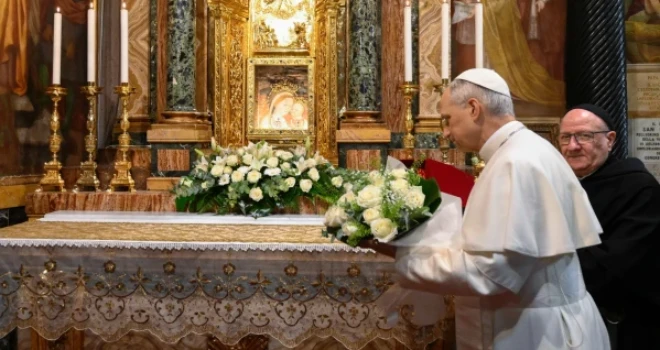Since the moment Cardinal Robert Prevost was elected pope, the faithful and the media have tried to learn more about his life, his spirituality, and his views on the main challenges facing the Church. Because Prevost was not among the most well-known cardinals, many have tried to infer much from his small gestures and initial words and choices, including his choice of name: Leo.
The last Bishop of Rome to choose the name was Vincenzo Gioacchino Pecci (Leo XIII), whose long pontificate (1878–1903) is remembered for his strong response to modern ideologies. Over the past several weeks, many have brought up Leo XIII’s Rerum Novarum, which contained both a firm condemnation of socialism and a strong defense of workers’ rights. To be sure, Leo XIV knows well his illustrious predecessor’s contribution to the social teachings of the Church. However, I would suggest that we should not overlook another aspect that may link the “two Leos” and their pontificates: their devotion to the Blessed Virgin Mary.
Leo XIII deserves to be remembered not only for Rerum Novarum, but also for his record twelve encyclical letters on the Holy Rosary. These and other documents from Leo’s pontificate are a sober reminder of the supernatural—not merely social—mission of the Church, of the role played by Mary in the history of salvation, and of the consistent attention dedicated by modern popes to the dignity of women and to the safeguarding of the family. In Leo XIII’s Marian encyclicals, we find first of all touching passages that demonstrate his personal devotion to Mary:
Throughout the many dreadful events of every kind which the times have brought to pass, We have always sought refuge with her, always to her We have lifted up pleading and confident eyes. […] When, then, it came to pass in the secret design of God’s providence that We were chosen to fill this Chair of St. Peter and to take the place of the Person of Christ Himself in the Church, worried by the enormous burden of the office and finding no ground for reliance upon Our own strength, We hastened with fervent zeal to implore the divine aid through the maternal intercession of the ever blessed Virgin. (Magnae Dei Matris)
Leo XIII was inviting every Christian to pray to Mary in times of crisis, in moments of fear or trouble or tiredness—and especially when we are called to do something that we do not consider ourselves worthy of doing.
At the same time, the Leonine encyclicals were an important catechesis on the life of Mary. For instance, the pope wrote beautiful sentences such as these:
[Mary] was born, it is true, of the royal family of David, but she fell heir to none of the wealth and grandeur of her ancestors. She passed her life in obscurity, in a humble town, in a home humbler still, the more content with her retirement and the poverty of her home because they left her freer to lift up her heart to God and to cling to Him closely as the supreme Goodness for which her heart yearned.
Finally, Leo XIII aimed to address some problems that must sound awfully familiar to us even in 2025, such as the hostile cultural environment in which we have to live as Catholics. In particular, Magnae Dei Matris criticized institutions of higher education and what we now call “the media,” for their rejection of the Christian Faith and for their mockery of God. Leo XIII indicated that petitions to Mary and the recitation of the Rosary by families were an appropriate response. Prayer is not a declaration of defeat, but rather the rallying of spiritual forces. Throughout history, Mary has helped Christians many times when everything seemed lost. In another one of his Marian letters, Augustissimae Virginis Mariae, Leo XIII remembered some of these moments of peril, such as the Battle of Lepanto, and praised the efficacy of public prayer.
Now that we have recalled that Leo XIII’s was a “Marian papacy,” can we find any indication of a similar devotion in the first actions of Leo XIV? The answer is yes.
First of all, on the very day of his election, when Prevost stepped on the balcony at St. Peter’s Square to address the crowd, he led the people in prayer by reciting a Hail Mary. As Catholics, we should rediscover the importance of public prayer, even though we may find this embarrassing in our secularized societies. By now, we should have realized that, if we privatize prayer and leave the public sphere devoid of religion, society will not simply remain neutral: neutrality is a fiction, and as public displays of Christian Faith have disappeared, various ideologies with their own liturgies (and covert spiritual messages) have filled the gap.
Furthermore, on the very day following his election, Leo XIV, in a very unusual move, decided to head outside of Rome to pay a visit to the Shrine of the Mother of Good Counsel, in Genazzano. At this church, Prevost met with his fellow Augustinian brothers and prayed in front of the famous image of the Virgin, a painting that miraculously appeared in 1467. Then, on Good Shepherd Sunday, Leo surprised the faithful by singing (rather than reciting) the traditional Regina Coeli hymn to honor Mary.
There were other actions that placed the Virgin Mary at the center of the first month of this new pontificate, but these examples should be enough to suggest that Leo XIII and Leo XIV may share more than an attention to current social problems. Pecci and Prevost share a common understanding of Mary as a model for all Christians. This Marian outlook is not abstract but very concrete, because the Rosary can help families and communities to pray together, and prayer is at the core of the Church’s mission.
Photo by Vatican Media
















